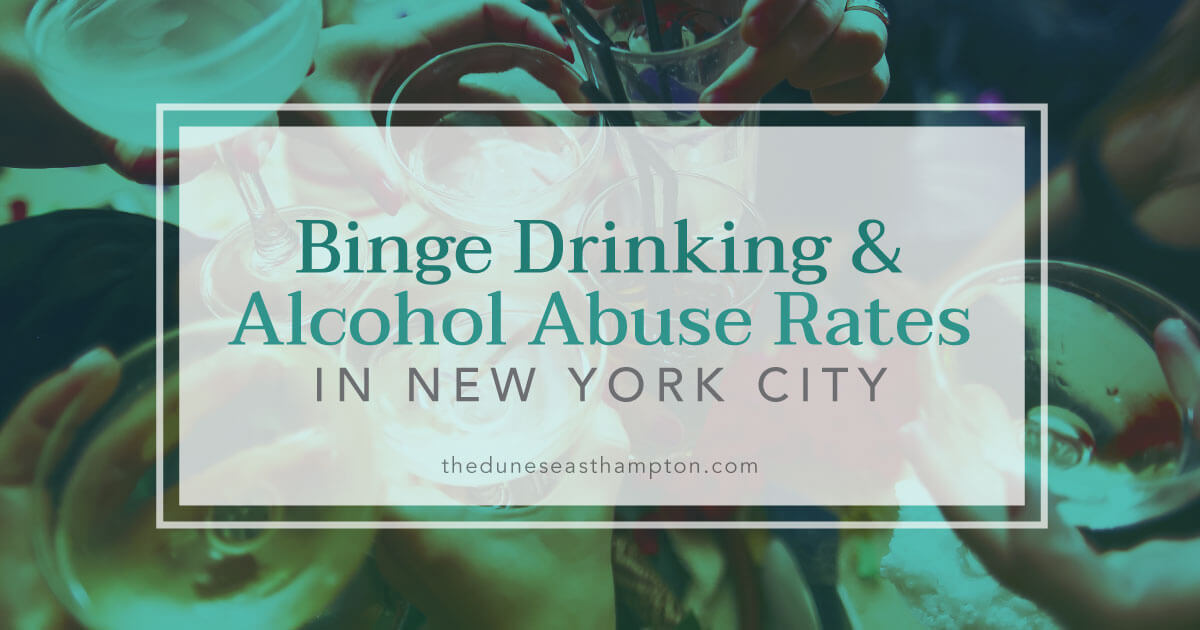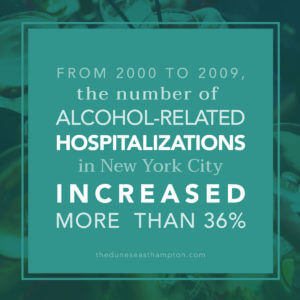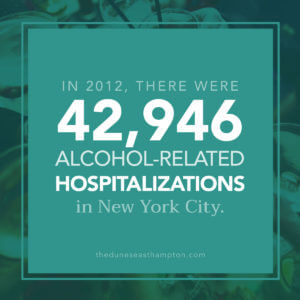 New York City is no stranger to drug and alcohol abuse, but the rates of binge drinking, alcoholism, and alcohol-related deaths have risen alarmingly in the last two decades. From 2000 to 2009, the alcohol abuse rates In NYC and related hospital visits increased more than 36 percent. The city recorded 8,840 alcohol consumption-related hospital visits in 2009. These numbers have only continued to rise steadily in the last eight years, pointing to the need for a change in the Big Apple.
New York City is no stranger to drug and alcohol abuse, but the rates of binge drinking, alcoholism, and alcohol-related deaths have risen alarmingly in the last two decades. From 2000 to 2009, the alcohol abuse rates In NYC and related hospital visits increased more than 36 percent. The city recorded 8,840 alcohol consumption-related hospital visits in 2009. These numbers have only continued to rise steadily in the last eight years, pointing to the need for a change in the Big Apple.
The Numbers Behind Alcohol Abuse Rates In NYC
In 2012, there were 42,946 alcohol-related hospitalizations in NYC. Males made up the majority at 29,932. The dominating age group was 45 to 54, followed by 55 to 64. The majority of these hospitalized patients were black (32 percent), followed by Hispanic (25 percent), white (22 percent), and other (21 percent).
Brooklyn was the most popular borough of residence for alcohol-related hospitalizations in 2012 (the most recent year for which data are available), followed by Bronx and Manhattan. Alcohol consumption across the U.S. is responsible for 10 percent of deaths among working-age adults. Excessive drinking remains the fourth leading cause of preventable death in America. A startling number of adults admit to excessive drinking in New York City
The Costs of Binge Drinking
In a recent study, the New York State Health Department discovered that more than 50 percent of underage drinkers admitted to occasional binge drinking. More than 40 percent of all New Yorkers who drink admitted the same. Binge drinking is a dangerous practice that most people refer to as simply “getting drunk.” The Centers for Disease Control and Prevention (CDC) defines binge drinking for men as having five or more drinks in about two hours. For women, it’s four or more drinks. Binge drinking raises blood alcohol content (BAC) levels above the legal driving limit of 0.08 percent in NYC.
Binge drinking can lead to loss of balance, dizziness, dehydration, lack of coordination, vomiting, diarrhea, lack of judgment, and loss of consciousness. Binge drinking sometimes leads to death when an intoxicated person passes out and vomits, leading to blocked airways and suffocation. Excessive drinking also may result in alcohol poisoning and death, as well as injuries from falling, drowning, and car accidents.
Alcohol-Related Car Accidents in New York
Every state has anti-drinking and driving laws, yet people still get behind the wheel intoxicated every day. About one in three car crash deaths in the U.S. involves a drunk driver. From 2003 to 2012, 3,752 people died in car accidents involving a drunk driver in New York. New York’s statistics are lower than national averages, but they are still too high for public safety. Alcohol was the No. 1 cause of car accidents related to human error in 2014, making up a whopping 94.2 percent.
In 2014, there were 7,849 alcohol-related crashes in the state of New York. In these accidents, 163 drivers were killed – 152 drunk drivers and 11 non-drinking drivers. Forty-seven passengers, 71 pedestrians, and 11 bicyclists also died. There were 5,674 people injured in these accidents. Abstaining from drinking and driving would have prevented every one of these deaths and injuries. Binge drinking significantly contributes to the number of these deadly crashes in New York City.
Costs to the State of NYC
Every year, alcohol consumption costs the United States upward of $223.5 billion. The majority – more than three-fourths – of this cost stems from binge drinking. In New York City, a significant portion of the statewide alcohol-related costs comes from underage drinking. Underage drinking costs New York about $3.1 billion per year, broken down as follows:
- $2.01 Billion in Pain and Suffering
- $732.80 Million in Lost Work Productivity
- $367.10 Million in Medical Costs
Youth-related alcohol abuse rates In NYC are a tragic reality, and it creates a host of serious issues, such as traumatic injury, crime, alcohol poisoning, homicide, suicide, and admittance into substance-abuse treatment facilities. All of these problems cost the state money – expenses ultimately covered by taxpayers. In 2012, 3,462 people between the ages of 12 to 20 went to facilities for alcohol treatment in New York, which amounted to three percent of all admissions in the state. Young people who consume alcohol before the age of 15 are four times more likely to develop a dependence on this substance.
 At least 640,000 underage people drink alcoholic beverages each year in New York. In 2013, 63.5 percent of 9th to 12th graders interviewed admitted to having at least one alcoholic drink in his or her life. Underage drinking leads to traffic crashes, violent and property crimes, injuries, and high-risk sex. In 2012, an estimated 31,600 nonfatal crimes, 33,000 property crimes, 618,000 public order crimes, and 44 homicides occurred in New York – all attributable to underage drinking.
At least 640,000 underage people drink alcoholic beverages each year in New York. In 2013, 63.5 percent of 9th to 12th graders interviewed admitted to having at least one alcoholic drink in his or her life. Underage drinking leads to traffic crashes, violent and property crimes, injuries, and high-risk sex. In 2012, an estimated 31,600 nonfatal crimes, 33,000 property crimes, 618,000 public order crimes, and 44 homicides occurred in New York – all attributable to underage drinking.
Young adults who engage in binge drinking are putting the health of their still-developing brains at risk. Brain development can last through ages 21 to 25. Young adults are at a greater risk of suffering from the consequences of heavy drinking, which can lead to loss of control, alcohol use disorder, and a wide range of accidental injuries. It also affects judgment, leading to dangerous situations when it comes to driving or interacting with others. Young adults who drink heavily also may commit crimes they otherwise would not have, leading to ruined futures. All in all, youth-related alcohol abuse and binge drinking contribute to the rate of adults with the same issue.
Personal Costs of Binge Drinking
Binge drinking and alcohol abuse harms more than just the state’s budget. It tears apart families in New York City. For too many people, social drinking becomes a reckless and harmful habit that hurts relationships. Excessive drinking can impact one’s personality, leading to alcohol-related aggression and abuse. Children of alcoholics often struggle with deep-rooted emotional and psychological problems from growing up without the attention and care they needed to thrive.
Alcohol abuse rates In NYC are tied to many social issues, including sexual assaults and drunk driving accidents. Many alcoholics simply don’t realize the immense personal costs of an alcohol dependency problem. Alcohol depresses the nervous system and can cause feelings of depression and anxiety. Alcohol can lead to various mood disorders or exacerbate existing ones. For example, there’s a well-established link between heavy alcohol consumption and schizophrenia. Studies suggest that heavy alcohol use may increase the presence of symptoms, such as hallucinations.
Alcohol and Drugs in New York City
Alcohol abuse rates in NYC have risen significantly alongside drug use drinking in recent years. There has been an increase in abuse of cocaine, heroin, marijuana, and prescription opioids. In 2014, heroin-related overdose deaths reached new peaks, rising nearly 24 percent from 2013. There were 825 overdose deaths relating to heroin in 2014 – 25 times the number recorded in New York in 2004. Prescription drug misuse and abuse also are on the rise.
Prescription opioid abuse and heroin abuse have gone hand in hand around the nation because both drugs are opiates. New York City has been no exception. In 2014, 1,008 people in New York died from using prescription opioids. This was a 250 percent increase from 2005. Overall, drug overdose deaths have risen significantly in New York, by 144 percent from 2005 to 2014. There were about 2,300 overdose deaths in New York in 2014. Alcohol and drug abuse is a growing problem around the country, but especially in metropolitan areas.
Statewide Efforts to Reduce Alcohol Abuse in NYC
 New York State has several initiatives in place to try to lessen the number of substance abuse cases. Current outreach campaigns include #CombatAddiction, #CombatHeroin, #StopSynthetics, and #Talk2Prevent. To curb the rising alcohol abuse rates In NYC, the health department released a series of advertisements with photos of New Yorkers “partied out” in the subway in 2012. The message was that if the people had abstained from binge drinking they would have made it home safely.
New York State has several initiatives in place to try to lessen the number of substance abuse cases. Current outreach campaigns include #CombatAddiction, #CombatHeroin, #StopSynthetics, and #Talk2Prevent. To curb the rising alcohol abuse rates In NYC, the health department released a series of advertisements with photos of New Yorkers “partied out” in the subway in 2012. The message was that if the people had abstained from binge drinking they would have made it home safely.
The Long Island Railroad ran a trial ban on alcohol sales one weekend in 2012 in the hopes of limiting the amount of binge drinking on the railway. The ban didn’t last past the trial run, but the Long Island Railroad still enacts similar bans on event weekends. In 2012, then-mayor Michael Bloomberg proposed restrictions on alcohol sales in the city, but this caused an uproar. Reining in alcohol sales will likely never be a popular decision in NYC, but it would potentially help reduce the staggering rates of alcohol abuse in the city.
Looking Toward the Future
Alcohol abuse rates In NYC signify the similar issues currently plaguing the rest of the country. About one in 10 hospitalizations in New York are related to alcohol. Even with these numbers, there is hope for the future. Underage drinking has decreased around the country, dropping from 28.8 percent in 2002 to 22.7 percent in 2013. Binge drinking also declined, from 19.3 percent to 14.2 percent. Heavy drinking rates fell from 6.2 percent to 3.7 percent. The state of New York hopes to reduce these numbers in the future through educational programs and anti-substance abuse initiatives.







